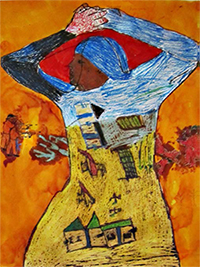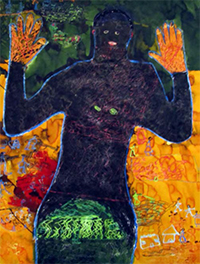
Makopane Thelejane |
"When I got the news of my husband is dead, I put my hands above my head, as you see me in this picture. I could not bear the ache in my heart." - Makopane Thelejane |
A woman looks down on a canvas covered in thick layers of red, dark shadows falling across her face. A brief moment that captures the silently-devastating aftermath of the Marikana massacre that bled into the lives of 34 widows.
It is this silent trauma that was at the centre of the last instalment of the Vice-Chancellor’s Lecture Series for 2015. “These stories of the Marikana widows are important. It is these stories of silence that live behind the spectacular scenes of the violence,” Prof Pumla Gobodo-Madikizela, Senior Research Professor in Trauma, Forgiveness, and Reconciliation Studies at the University of the Free State (UFS) said at the event.
Panel
The lecture, which took place on Monday 27 July 2015 on the Bloemfontein Campus, took the form of a panel discussing the theme of “Speaking wounds: voices of Marikana widows through art and narrative”. The panel consisted of members from the Khulumani Support Group, including Dr Marjorie Jobson (National Director) and Judy Seidman (Sociologist and Graphic Artist), as well as Nomfundo Walaza, former CEO of the Desmond Tutu Peace Centre.

Betty Lomasontlo Gadlela |
"Then this dark time came, a dark cloud over me. It made me to have an aching heart, which took me to hospital, from losing my loved one, my husband, in such a terrible manner. " - Betty Lomasontlo Gadlela |
Trauma made visible
In a project initiated by Khulumani, the Marikana widows were encouraged to share their trauma through painting body maps – in which the widows depicted their own bodies immersed in their trauma – and narrating their personal stories. Throughout the workshops, the focus always remained on the women. As Siedman put it, “the power of this process is rooted in the participants. The statements of what the participants experienced is what’s important.”
Initially silenced and isolated, this group of women has now moved “into a space where they have become connected to each, and stand up for each other in the most powerful ways,” Dr Jobson said. “Our work is conceptualised in terms of giving visibility and voice to the people who know what it takes to change this country; to change this struggle.”
The transformative power of art and narrative
During her response, Walaza pointed out “how art and narrative can transform traumatic memory and become integrated in the survivors’ life story.” This gives individuals the opportunity, she said, “to step into a space of mutual listening and dialoguing in which people bond together.”
Co-hosted by Prof Gobodo-Madikizela and the UFS Institute for Reconciliation and Social Justice, the lecture series forms part of a five-year research project funded by the Andrew W. Mellon Foundation.